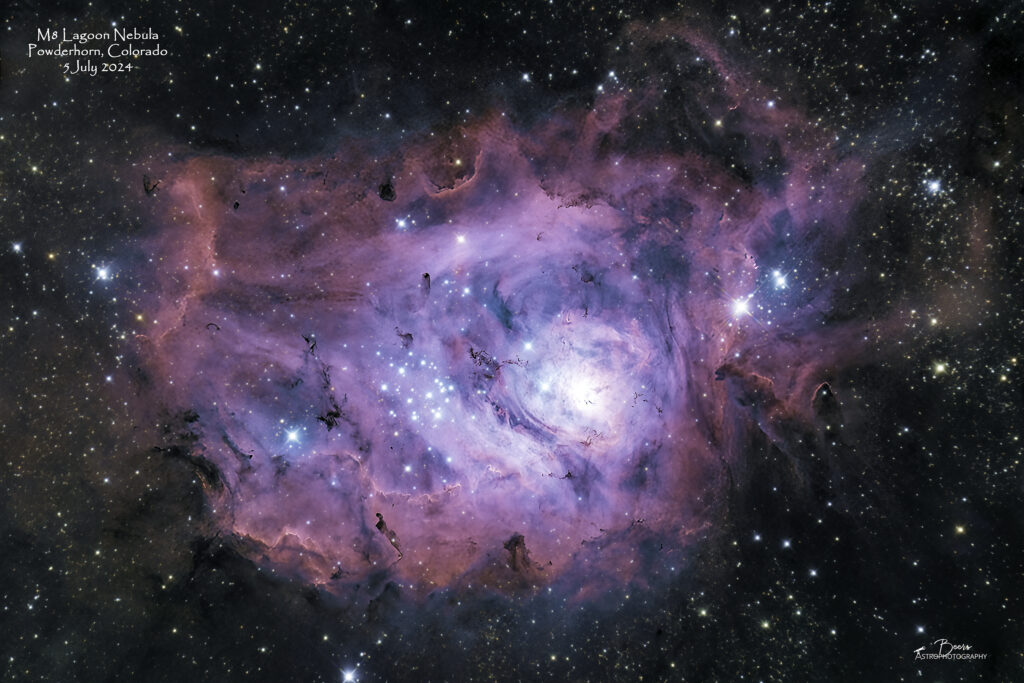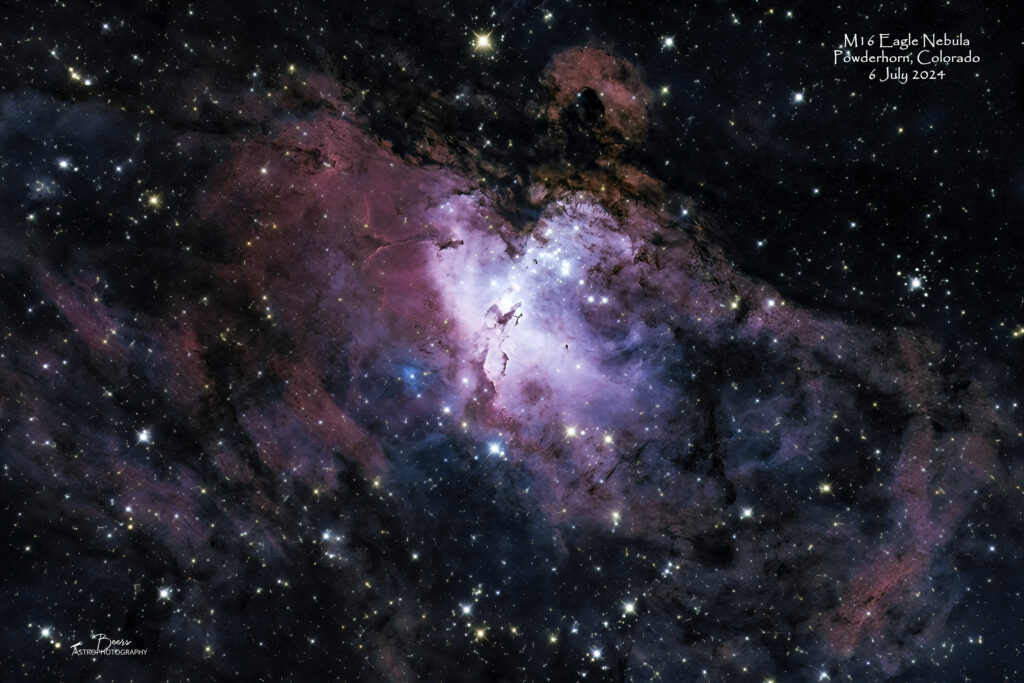We finally had a forecast for clear skies at a dark skies location during the New Moon weekend! (You may recall that the last time we had that was in January – for one windy and cold night!) So we packed up the Beast – with both the Southern Cross and Big Bertha (and all their paraphenalia), all our camping equipment, gourmet meal fixings, and Zeus – and headed to the Gunnison, Colorado area. We camped for three nights over the 4th of July long weekend very near to the spot we camped last June on BLM land near Powderhorn. We had windy days, but gloriously dark and still nights allowing me to capture data on seven (YES – 7!!) targets.
The camp and set-up…

We finally had the the perfect astrophotographer’s trifecta – clear sky forecast, at a dark skies location, during the New Moon weekend! So we planned a dark skies trip to the Gunnison/Powderhorn/Lake City, Colorado area. We departed HCH on the 4th of July at 0730 and arrived in the Gunnison/Powderhorn/Lake City area at about 1230. There were a number of road closures, including the bridge on Highway 50. Luckily the bridge closure was west of the turn we planned to take onto Highway 149, the Silver Thread Highway. Paul had planned several potential camp spots that were in the area beyond the ridge where we had camped in June 2023. After driving around to several of the areas and not finding anything suitable – either because of the brush, lack of access, or areas near the creek that would likely be mosquito infested – we decided to head back to the area where we camped last year.
When we got to that turn off, shortly after taking it we came upon a “road closed” sign. We were almost deterred, but decided to drive past it rationalizing that where we were going wasn’t too much farther down the road and we saw no obvious reason for the closure (we learned later from a local resident who came by our camp on Friday, that the neighborhood had put up that sign to deter people from turning there thinking it was the Hwy 26 bypass for the bridge outage). So, it turned out that we could have gone to the area on the top of the ridge that we’d found on our drive out from the 2023 camp, but we were a bit spooked by the sign and didn’t want to go that far to be turned around or stuck. We landed at a site VERY close to the site (probably less than 500 feet up the road!) where we camped last year.
We set up camp (during which time we discovered that the sink macerator pump was not working), I set up the Southern Cross, helped Paul with the pump investigation (it’s broken, so I ended up washing dishes in a bucket using the hose at the back end of the Beast on this trip!), then set up Big Bertha (without the EAF because it was getting late, that one is a bit more complicated with the digital printed mount (or so I thought), and I didn’t want to deal with in the wind. We had a quick dinner and I got the first night’s imaging going.
Mother Nature delivered – three successful nights of imaging…
Thursday, 4 July 2024, Powderhorn, Colorado BLM land
On the night of 4 July 2024, I imaged SH2-129 Flying Bat Nebula with the Southern Cross – for an attempt to gather a night of data on my OCD target from dark skies at Gain 300, 10 minute exposures. I had a flawless night of capturing 33×10 minute exposures. When I stacked the images on the following morning, I was dismayed to find the Sequence Generator Pro (SGPro, the SW I use to control the mount) Framing and Mosaic Wizard (SGPro’s planning tool that allows you to frame the view of the target that you’d like to capture) is still not handling the camera angle correctly. I planned the image with a camera angle of 36° to capture the nebula in a landscape aspect. I set up the camera precisely at 36° during my initial set-up only to be told my SGPro during the initial plate-solving that the camera was at 147° and needed to be rotated 111° clockwise. When I did the rotation and executed the sequence, the image turned out to be approximately 90° (actually probably closer to 111°) from the intended framing – in a portrait aspect instead of the landscape aspect.
I did process the image – but I will NOT be posting it. Because first, it is not in the correct aspect, which will make the first reaction in viewing the image be “why didn’t your frame the the other way?” Second, the attempt at collecting at the that gain/exposure combination did not reveal the OU-4 Giant Squid (the faint portion of the image that looks more like a flying bat) as I’d hoped. So, a night of dark skies time spent on learning lessons…
Thankfully, Big Bertha had a much more productive evening! On the drive to the camp site, Paul had mentioned the NASA APOD image from a few days prior. When I went to their site, I decided to see what the image of the day was – it was entitled “Red, White, and Blue” – an image of M20 Trifid Nebula. M20 was on my target list, for the following night – seeing that with it’s tribute to the Nation’s birthday, I decided to move it forward and capture my own version of the image. The gallery post is at: https://beersastrophotography.com/gallery/m20-trifid-nebula/ with target fun facts and the information about the data capture.
One other interesting thing happened on that night and the following morning… As I was doing the initial plate solving with the Southern Cross, the first plate solve image was filled with criss-crossing satellite trails. The rest of the images captured throughout the night didn’t seem to have any evidence of them. But when I went outside to shut down the SC at astronomical twilight – I paused to look up and to the east there was a train of satellites crossing the sky! Ironic because during our DAF SAB meeting the previous week, one of my colleagues (Jim Chow) asked me if Starlink had been interfering with my imaging – I told him “no, I’ve seen them in my set-up but never in my images.” I still didn’t see them in my images, but I certainly saw them with my naked eye!

Friday, 5 July 2024, Powderhorn, Colorado BLM land
During the day, I attached the ZWO EAF (auto-focuser) to Big Bertha and set the focuser settings in SGPro to the same (changed) settings I had established for the Southern Cross. I selected targets from my list for the night: SH2-126 Gecko Nebula for the Southern Cross; M8 Lagoon Nebula and NGC7380 Wizard Nebula for Big Bertha.
On Big Bertha, the EAF kept failing – the delta between the first two data points was very steep and then the remaining points were essentially on a straight line. I struggled through the initial focusing routine, but went into SGPro and turned off auto-focusing for the rest of the night. The individual subframes on M8 Lagoon Nebula, as they were captured looked great, so I decided to continue with my plan of changing targets at M8’s meridian flip (~0035) to the Wizard Nebula for the rest of the night.
The gallery post of M8 Lagoon Nebula is: https://beersastrophotography.com/gallery/m8-lagoon-nebula/ with more capture information, target fun facts, and another image I captured of M8 early in my astrophotography adventure.

The second image captured by Big Bertha was NGC7380 Wizard Nebula. I’m still not seeing the Wizard namesake in this one, but perhaps if any of your are Harry Potter fans you do and can point it out to me?? If so, please use the Contact Me to let me know! The gallery post is: https://beersastrophotography.com/gallery/ngc7380-wizard-nebula/

After I got Big Bertha started, I got the Southern Cross started on the Gecko Nebula – again the autofocuser performance wasn’t great…although it didn’t fail like it did with BB, I decided not to lose the time during the data collection and unselected “use autofocus” for the rest of the sequence (night). The target rose at right about 2200 and was set to do its meridian flip at 0445 – perfect timing for when astronomical twilight was ending – so SC ran all night collecting data on SH2-126 and LBN437 Gecko Nebula. The gallery post is: https://beersastrophotography.com/gallery/sh2-126-lbn437-gecko-nebula/ with more of the gory details of data capture and a few target fun facts (this object isn’t listed in many of the references that I typically use (i.e., Wikipedia)

Saturday, 6 July 2024, Powderhorn, Colorado BLM land
On Saturday morning, both to facilitate our early Sunday morning departure (to get ahead of the 4th of July returning home to Colorado Springs traffic) and because they hadn’t been used throughout the night anyway, I disassembled the autofocusers from both the SC and BB. I also selected my night’s targets. For both rigs, I had two targets left on the list.
For the Southern Cross, I had planned IC4604 Rho Ophiuchi Nebula and then a switch to SH2-132 Lion Nebula. After looking at IC4604 – I decided it was too low (only rose to 28 degrees) and too big (required 2-tiles). So, I moved that object to my Southern Hemisphere target list for March 2025, and spent the full night on SH2-132 Lion Nebula. The gallery post for the Lion Nebula is: https://beersastrophotography.com/gallery/sh2-132-lion-nebula/

For Big Bertha, I also had two targets left on the list – M16 Eagle Nebula and NGC6888 Crescent Nebula. Again, I opted for spending the full night on one of them – M16 Eagle Nebula – because I felt NGC6888 would be better captured with Big Zeus because of its smaller size and wouldn’t suffer from a front-patio imaging with light pollution filters because of its predominant red coloring. The gallery post for M16 is: https://beersastrophotography.com/gallery/m16-eagle-nebula/ with target fun facts, capture information, and additional images captured with all of my telescopes!

